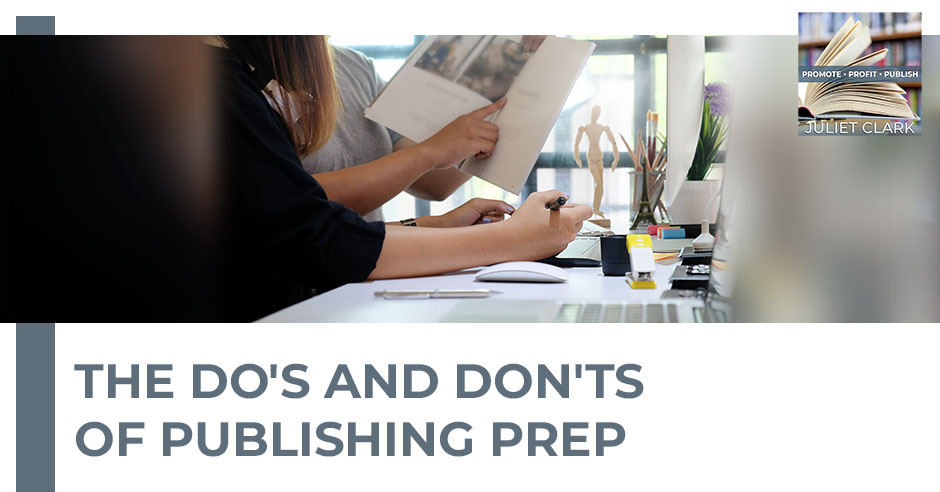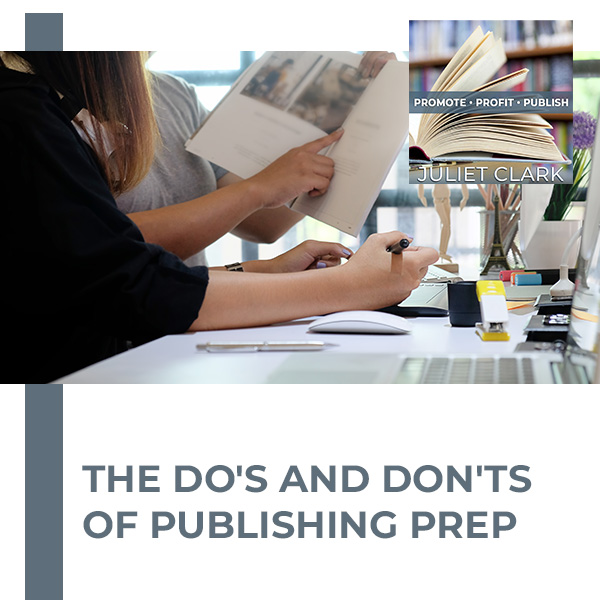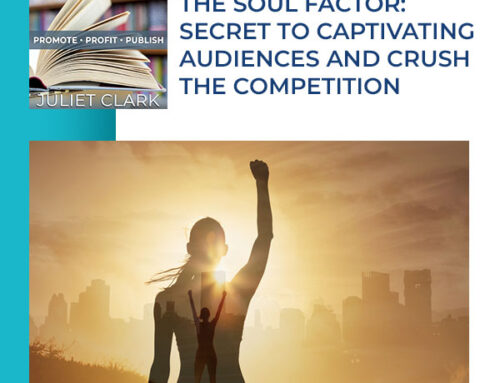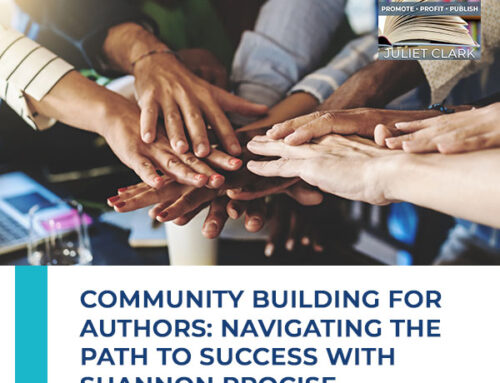
Being prepared for the publishing journey doesn’t only help you save time and money. It is also essential to taking your manuscript to the next level and making your publishing experience a success. Come and explore the world of publishing prep with our amazing host Juliet Clark in this insightful episode. Juliet discusses the essential dos and don’ts of being prepared for the publishing journey. She covers all important aspects of publishing, from formatting your manuscript to avoiding hidden fees in your publishing package. She also offers valuable expert tips to help you succeed in the industry. Tune in and get started with your publishing prep!
Grab a copy of Breakthrough Author Magazine at BreakthroughAuthorMagazine.com.
If you’re thinking about publishing a book, and you’re not quite sure, check out AuthorTrafficSchool.com.
—
Watch the episode here
Listen to the podcast here
The Do’s And Don’ts Of Publishing Prep
Before we get started, I want to send you over and get your free copy of Breakthrough Author Magazine. You can get that at www.BreakthroughAuthorMagazine.com. Free tips and tricks. We have some news. We’ve started adding some guest authors as well to what we’re doing, so I feel like it’s growing. I’m very excited about the growth. Also, remember to go check out Author Traffic School. If you are even thinking about writing a book, books are sold online and if you don’t have that digital presence to build an audience, it’s time to go get it. You can check that out at AuthorTrafficSchool.com and you can always book an appointment and talk to us personally about your needs.
On any given month, we probably have 6 to 10 new traffic school clients and none of them need the same thing. They’re all at different stages of development with their platform. Some of them have already published their first book and realized, “I didn’t have what it took.” As they’re writing their second book, they’re getting in there and getting all of that done as well and building for that second book.
Preparing For The Publishing Journey
In this episode, I want to take something a little bit near and dear to my heart that I see out there and it’s being prepared for the publishing journey. If you’re prepared, you can not only save a lot of time, but most of all save money because there are so many things as you’re going along. I’ll admit, they get a little bit angry because they’re like, “I didn’t understand that. What do you mean it’s going to cost an extra $350?” I want to put out there what you need to avoid those extra charges that happen as part of your publishing package. All of it is truly about being prepared.
I want to start with the manuscript. Many times we get a manuscript in-house and that’s great, but is it edited? I don’t know if I can stress enough about having your cousin Beverly, who is an English teacher, edit your book. I’m sure she’s a great person, but it’s probably not formatted as a book should be formatted and not written the way a book should be written. It is important to use somebody who is a book developer and editor.
We have some great people we work with. Jared Rosen does a great job at Green Scope with developing books. Chris Johnson does a lot of our editing work for us in book development. It depends on what book you have and how you work. I’m going to mention one of my friends from the Dames, Maggie Mills, again, a tremendous book developer. That’s what you need to get that book off the ground and the way you want it to be.
When you bring a manuscript to a publisher, it needs to be exactly the way you want it. One of the big challenges we have is when somebody brings us a manuscript and then they say, “I want this and this in there, but it’s not in there.” We are communicating to a third party here who sets it up. When you give us that manuscript, we want it exactly the way you want it. Drop the pictures in where you want it, drop the graphs or if you have little icons in there, make it exactly the way you want it so that the formatter can stylize it that way. It’s much easier than trying to give accessory instructions to somebody who’s setting up a manuscript. Do have it the way you want it.

Preparing To Publish: When you bring a manuscript to a publisher, it needs to be exactly the way you want it.
Here’s another thing, too, with the images. Give us a separate folder with the actual images because sometimes, when it goes through the internet, it loses some of the DPI. When you send us that individual image and then the manuscript with the image already in it, if we need to, we can pull the one out that’s in the manuscript and put a new one in.
First, things we often find are missing from manuscripts that are important that you need to get in there, which is acknowledgments. Put them in the document when you send, those are all your thank yous. Thank yous for people who helped you with research, your editor, or your mother. I got mother and father in my books. Have that already pre-written and pre-edited? That’s very important because, as you’ll see, when I get to the part where we talk about the don’ts, it’s going to cost you money if we have to keep sending them back to the formatter. It’s much easier for the formatter if it’s in the place where it needs to be because then they don’t have to take a bunch of different documents and try to put them together.
Next is your foreword. Your foreword is important and here’s why. If you get someone who already has books out or is already famous, when we put that foreword into the system, we’re going to connect with their books. What do we mean by that? If I say foreword by and it’s another published author, that puts a link there. When people search for that other author, your book comes up. I’m going to give a great example. We have someone whose foreword is being written by Brian Tracy. When we put that in the system, you can find it under the author, but if you search for Brian Tracy, that book is going to come up as well. That could be an added layer of credibility for you when those books come up.
Where You Start Getting Money
Here’s another thing. Before you put it in your manuscript, make sure that it’s fully edited. We get forewords all the time that haven’t been edited. I’m going to give you an example of one we got. It was written by someone in the California House of Representatives. She didn’t write it. She handed it off to an assistant who wrote it and didn’t do a very good job. When we got the proof, it was like, “Uh oh,” and we had to send it back to someone to edit and then redo the manuscript. That’s where you start getting into more money besides your initial publishing fee.
Endorsements. Your endorsements need to be in the front of your book too. We always choose 1 or 2 for the back cover or the front cover that we can put on as well. Those also go into the platform descriptions when we upload. Make sure they’re edited. You would be shocked how many we get that have misspellings. Here’s the other thing too. Make sure that it’s 2 to 3 sentences. Literally, we’ve gotten 2 or 3 paragraphs. It’s like, “We can’t do anything with this. It’s too long.” Make sure that the person who endorses you have their credibility points. You have the endorsement written and then it’s Juliet Clark, author of Pitchslapped or whatever they’re the author of. Make sure that happens.
Endorsements is where most of our authors get hung up because they don’t think about it until the last minute. As my author Sarah Carlson told me, “Endorsements are hard to get.” Here’s the deal. You go out and you can ask somebody to do it and they’ll say yes. You send them part of the book or the book and then they don’t do it. You end up, after about a month writing a bunch of endorsements that you can send and say, “Do you like any of these? Would you like to finesse them a little?” That happens a lot.
That brings me to the next part. Are you going to send around eCopies or are you going to go into what are called advanced reader copies? Most professional companies will encourage you to do an actual advanced reader copy. It does cost a little bit more because we’re formatting what you have of the book without the endorsements and a mockup cover into a book that can be mailed to them. There’s formatting. There’s uploading. There are all of the things that go along with an advanced reader copy.
Those are called ARCs. You should decide, depending on how professional your book and your audience is do you want to do an ARC? Do you not want to do an ARC? The thing about an ARC is you need to give yourself enough time before publishing to make it happen. I would say if you start your publishing journey a good nine months and you get those ARCs out there, you’re going to get a better result than sending an eBook around.
If you start your publishing journey a good nine months and you get those arcs out there, you're going to get a better result than just sending an e-book around. But you can definitely do both. Share on XYou can definitely do both. It’s always nice to get a professional to write your endorsement when they have a mockup of your book in hand, like a real physical copy. That’s something that needs to be decided as well. Remember, these are your testimonials. We want to make sure they’re good. They not only go inside the book, but they go on the platform as well. If someone finds your book, they read the back cover and then they realize that all of these important, credible people in your field have endorsed it, you’re going to have so much more gravitas and possibly more buyers than you would without it.
Indexes. If you are someone who’s done a more complex book and the index is in the back, make sure that you have it put in but also expect it to change because when we format books, we add extra pages. A lot of times, we want that chapter to start on the right-hand side, which means we change up your document. When your index is done, the page numbers that are in the index are not going to match what’s in the formatted book. This happened to Nan Nelson. I won’t say who she published her neonatal book with, but they didn’t tell her that.
She got the book and she got the proof but never realized until later that the index was completely obsolete. It didn’t match anything. She’s a doctor. Quite frequently, other doctors, other medical professionals, they’re going to flip to the back to see where you got those theories, where you got those papers, can they find them? Are you credible? That’s very important.
Table of contents. Make sure your table of contents is in the book, but you don’t necessarily need to add the numbers. The formatter will go back and do that once they’ve formatted the book, because, again, it’s all going to change. We add stuff in the front and we add pages in the back. For the pages in the front, we’ve got to add that ISBN page. The biggest thing that happens is that when we want the chapter to start on the right-hand side, all the pages in your Word document that you submit change. That’s another thing.
While the topic of Word document versus Google Drive, don’t ever submit your book in a Google Drive, and here’s why. We had an edited book done in a Google Drive and then the author thought that the grammar in the book maybe didn’t match what she thought. She put it out to all of her friends, who went in and edited the entire book all over again and it was a poor editing job. Their suggestions weren’t what they were supposed to be. She took it back to the editor and she’s like, “My friends made a mess of it. Will you edit it again?” She was shocked that the editor wanted to charge her again, which I can completely see why.
The other thing too, and we had this happen many years ago, is an author submitted the editor’s copy. She didn’t go in and accept the corrections from the editor. When we got the proof because I just took it, I was only a self-publisher back then, she was pretty shocked. She’s like, “What are these red lines in here?” “That’s because you didn’t edit and you didn’t accept the changes.” Remember that as well. Table of contents, no page numbers.
Images, tables, graphs. Don’t go pull screenshots. You need images in that book that are 300 dpi or better. Remember when you’re doing this, when you submit color images for a black and white book, there are gradations of color. You have to make sure that it’s super crisp because that red might be a little bit darker shade of black. You’re going to have these other gradations in between with other colors that may not be as crisp when you take them from 300 dpi colored to 300 dpi black and white.
That’s one of the concerns. A lot of times, people will go and they’ll grab something off the internet, like a graph or something like that and it’s not 300 dpi. You can’t see it much in the digital copy or the digital proof. When you get your proof in hand, it’s a problem. You’re like, “I have to go back and have this redone.” If at all possible, jump over to someplace like Fiverr and have an infographic or whatever it is you’re doing professionally done so that it is the right dpi.

Preparing To Publish: It’s not just writing your book. It’s actually a copywritten piece of marketing material that entices people to write your book.
That cover copy. What’s your book about? At least have a preliminary written and remember to get help on this because that’s copywriting. It’s not just writing your book. It’s a copywritten piece of marketing material that entices people to write your book. It is important to have it written by a copywriter, not just you putting down this is what your book is about.
Front cover mockups. Bring one to your publisher and you can go over to places like Upwork and Fiverr and have something like that mocked up pretty cheap. You’re at least giving your publisher who may come in and do a different cover an idea of what’s in your head with a visual. What happens sometimes is that an author will come to me, they’ll give me an idea, I’ll write the idea down for the cover designer and somewhere in translation, it all gets lost. I’m going to share with you, if you haven’t read Gretchen Hydo’s book, Break Free of Your
Dirty Little Secrets, it’s an amazing book. When we started out, her idea was racy dirty little secrets.
When she described the book, I turned around and I described it to the author. “It’s a book for women. The cover needs to be racy. It needs to be secretive because these people are keeping secrets.” What we got back, I’ll show it to you guys sometime. When I read an article, it was the difference between is this romance or porn? Not self-help. It was literally a sexy woman with a blindfold over her face and you couldn’t tell if it was erotic fiction or not.
Once we got Gretchen with the designer speaking directly to them, we got a beautiful self-help cover that reflects what the book is about. I want to impart upon you. When you’re working with the designer directly, cut out that middleman and go and tell him what you want and then go back and forth about it. It’s helpful for your publisher and it saves a lot of time and frustration. We had an author back in March of 2020 who literally had 34 revisions because she had no idea what she wanted. It was difficult because she couldn’t make up her mind and then she didn’t like anything she saw and the cover became a major sticking point in the whole project.
What else does your publisher need? Let’s go into a couple of things. You need a current professional picture taken image for the back of the book. This is not something you can snap with a camera. Go get a nice professional picture taken. Chances are, if you’re an entrepreneur, you need it for your business anyway. It doesn’t hurt to have an updated one.
Short, Medium, And Long Bios
Bios. We’re looking for short, medium, and long bios. Why do we need so many? First of all, the short bio, there’s only so much room on the back of the book. It needs to be 3 or 4 sentences about who you are concisely. The medium bio and the long bio we can use on the platform. We have huge spaces where we can put in author information and so have those bigger ones there. If someone is looking online, they can go and say, “That person did this, this and that.”
Make sure those are copywritten too. We don’t want this boring, “I graduated from Cornell University with a degree in Biomechanical Engineering.” I made all that up. That’s not me. I’m not that smart. There’s all of that. Have it written in a way that’s engaging. Most of all, put some things in those bios. Maybe not the short one on the back of your book, but on the other ones that make you seem human and approachable.
One of the things is you’re building credibility and you’re building authority, but you also want to be open to conversations and clients, so you have to be approachable. There’s nothing worse than an entrepreneur who’s not approachable. Believe me, I’ve worked with a couple of them, I’ve hired a couple of them and it’s not a great way to work. I would never hire them again. I wouldn’t refer them. You have to be human for people.
When you write your author’s bio, you're building credibility and authority, but you also want to be open to conversations and clients, so you have to be approachable. Share on XPeople are going to need your citizenship and your birthday. I know this thing is funny, but when we apply for an LCCN, they want to know what year you were born. When we apply for copyright, they want to know that you’re an American citizen. Have that available. Maybe I shouldn’t assume. It makes an ask out of you and me, but occasionally, I’ll ask someone, “Are you an American citizen?” I know we had someone from Sweden and yes, she was, but the birthday too. Most people, especially women, are like, “Are you asking me how old I am? How dare you?” You have to ask anyway. You have to get that year. It’s very important.
Your Amazon login as well, especially if you’re working with us because we put your KDP, your actual Kindle copy. Since we don’t take back in profits from any of our authors, the royalties are truly your royalties, we’re going to go in and set that up on KDP and there’s some information you need. In addition to that, you’re probably going to want to have a bank account, LLC information, and whatever you need to fill out a tax document for them as well.
You have all this prep done. Let me talk to you about the consequences when you don’t because this is where authors get frustrated. We will get the proof in hand and now all of a sudden discover that there are some things they forgot or mistaken then it starts costing money. I have a negotiated contract with my formatters. We get three rounds. Above and beyond three rounds, now we have a cash outlay for every round above that. We had an author who had fifteen revisions. It was absolutely livid. How could this happen?
It was simply not paying attention to detail. I hate to say there was a little bit of, “I’m so important and my book is so important that you must do this,” it’s awful. Here’s the other thing. Not only do we have to send it back to the formatter, but every time we upload it to the platforms that send out to the distributors, they charge too. Past those three revisions, we’re occurring quite a bit in charges and we pass those on to you guys because we consider it you not prepared with your publishing to be published.
What does that look like if we have to redo your manuscript? $350 and we don’t mark that up. This is what the formatter is charging and what the new upload is. This is where it starts snowballing when we make it. We’ve had to change your manuscript. If we have to change the page count, now we have to go back to another formatter and ask for them to redo the spine. That’s another $350. Back to the formatter, the formatter is charging back to the platform to upload. They’re charging.
It gets even worse. If it’s the manuscript that’s changed, now we have to redo all the eBooks. Now you’re into it for another $750. That’s where this is important that you get it right in those three revisions where if you’re prepared, it’s done. We’re good. I hate to charge for those charges, but they’re not the cost of doing business. They are a cost that we pass on to the author because they didn’t come to the table prepared. It’s very important.
I mentioned the cover design. Every time we change the page count, we have to go back in and get the spine redone. We need to go pull new templates. These are all things that you need to keep in mind and why you need to be so prepared. The number one thing that causes this to happen besides additions and all that are bad images. We had this happen. One of our authors got his proof in hand and he said, “This chart on page 74 doesn’t look crisp.” He’s gone back now to a different designer. He’s had it redone, it’s 300 dpi, but I have to charge him.
It doesn’t change the page count. It doesn’t change anything except the manuscript. We looked at the digital proof. It looks great on the digital proof, so we don’t have to redo the eBook, but we do have to redo, go back and insert the chart, and re-upload. You have to make sure that those images look good from the get-go. It’s very important.
Another thing that’s going to cost you, not editing. Get a good professional edit and make sure when you submit that manuscript that everything is where you want it to be. If we have to go in and make changes, again, I went through all of those, sending it back to the formatter to make those changes. The number one thing we see is edit mistakes where you went back in and you didn’t accept the edits or there was a clarification and you didn’t read through properly.
Let me tell you how hard this is because by the time you get to publishing, I hate to say it, you’re excited about your book, but you’re so sick of your own book because you looked at it so much. This is going to cost you on that because you have to redo the manuscript. Chances are you’ll have to redo the eBooks. It’s very important.
By the time you get to publishing, you're excited about your book, but you're so sick of it too because you've looked at it so much. Share on XThe, “Oops, I forgot.” Nothing gets to me more when you come back and you say, “Spirit told me to add this.” Does the spirit have the money for you to add it? We’ve gone through that significantly lately where people say, “I forgot to put this in the book.” You probably had that book for a long time. Don’t forget to put everything in the book. Spirit may be telling you that you need it in the book, but maybe you need it in your next book, not this one.
I want to express to you that we love working with authors and that’s why we start so far in advance. We want you to have all of your ducks in a row. We work on a lot of this with you. What we don’t do is edit your manuscript. We don’t edit other things in the book. That part of it has to be good from the time we get it to produce a fabulous product. That means not only being prepared but also hiring good people along the way.
I’m going to share something with you that was probably one of my first learning experiences. My first book was a pretty crappy book. I got to admit I’m not the world’s best writer, but Stephen King’s first editor before his current editor edited that book. It was a shock to my system because in a world where we’re all going back and forth with these digitals with, “I’m going to send you my Word doc,” to the editor and, “You’re going to send me back with all the edit lines.” He had me print it out and I had to mail it to him. You would be shocked at how much red came back. I almost cried. I had to go in and manually make those corrections and that was great.
When I got into my second book, a woman who wanted the editing work and told me that she had edited many books came and pretty much begged me to let her edit my book. I did. I got the second book out and it did much better. The third book, she edited as well. That’s when my books took off. Now I had a lot of scrutiny versus 1,000 people who bought it. I think the first 113 copies and probably most of them were from my grandmother. The second book sold more. I didn’t get much criticism about the editing.
The Importance Of Good People
The third book, I sold over 25,000 copies. I literally had reviews that said, “Who edited this? A monkey?” It was awful because this book become like your baby. They’re like your children. You nurture them. You love them. That was my wake-up call about a bad editor. Unfortunately, she had already edited my fourth book. It is important that you hire good people. In this day and age, I see major books from major publishers that have errors. I remember reading a Stone Barrington book and there were probably 6 errors in 3 pages, and this is a major publishing house. Make sure that you learn or work with good people on these projects because believe me, the reviewers, the people who read your book will let you know if it’s not good or if something is not right.
I do want your publishing experience to be great and things like this ruin the experience, but they’re all learning lessons. When you publish your next book and your next book, you learn from every single book and it will all be better. I know a lot of you, this book is your one book, so it’s not going to happen again. I hope that helps. As usual, if you have any questions or concerns, leave us a review. Go over and follow us at Superbrand Publishing over on YouTube. If you want to talk to us about publishing or building your author platform, go get on my calendar, ChatWithJuliet.com. Have a wonderful day.
Important Links
- www.BreakthroughAuthorMagazine.com
- AuthorTrafficSchool.com
- Pitchslapped
- Break Free of Your Dirty Little Secrets
- Superbrand Publishing – YouTube
- ChatWithJuliet.com
Love the show? Subscribe, rate, review, and share!
Join the Promote, Profit, Publish Community today:
- superbrandpublishing.com
- Promote, Profit, Publish on YouTube
- Follow Juliet on LinkedIn
- Take the Quiz!









Leave A Comment